A Comparison of Fiber Optic Transceiver Modules for Industrial Use

Understanding Fiber Optic Transceiver Modules
Fiber optic transceiver modules play a pivotal role in modern industrial applications, facilitating high-speed data transmission and connectivity. Let's delve into the fundamental aspects of these essential components and their significance in industrial settings.
What Are Fiber Optic Transceivers?
Fiber optic transceivers are compact, integrated devices that transmit and receive data over fiber optic cables. They serve as the interface between optical fibers and electronic devices, converting electrical signals into optical signals for transmission and vice versa. These modules are designed to support various communication protocols, including Ethernet, Fibre Channel, and SONET/SDH (Synchronous Optical Networking/Synchronous Digital Hierarchy).
Importance in Industrial Applications
In industrial environments, where reliability and efficiency are paramount, fiber optic transceiver modules offer unparalleled advantages. Their ability to transmit data over long distances with minimal signal loss makes them indispensable for industrial automation systems, control networks, and sensor applications. Moreover, their immunity to electromagnetic interference (EMI) ensures stable operation in harsh industrial settings where traditional copper-based solutions may be susceptible to disruptions.
The deployment of fiber optic transceivers also contributes to enhanced network security by providing a secure medium for data transmission. This is particularly critical in industries where sensitive information must be safeguarded against potential cyber threats.
Exploring Different Types of Fiber Optic Transceivers
In the realm of fiber optic communication, various types of transceiver modules cater to diverse industrial requirements. Each type possesses unique characteristics and is designed to address specific connectivity needs. Let's explore some of the most prevalent fiber optic transceiver variants utilized in industrial settings.
SFP Transceivers
Cisco Transceivers
Cisco, a leading networking hardware company, offers a wide range of SFP transceivers tailored for industrial applications. These modules are engineered to deliver high-performance data transmission over short and long distances, making them suitable for diverse networking environments. Cisco's SFP transceivers are renowned for their reliability and seamless compatibility with an array of networking equipment, ensuring consistent connectivity in industrial setups.
Juniper Transceivers
Juniper Networks specializes in providing robust and efficient SFP transceivers optimized for industrial use. Their transceiver modules exhibit exceptional compatibility with Juniper's networking devices, offering reliable data transmission capabilities across varying industrial scenarios. With a focus on performance and durability, Juniper's SFP transceivers uphold stringent quality standards, meeting the demanding connectivity needs of modern industries.
Arista Transceivers
Arista Networks introduces a comprehensive lineup of SFP transceivers, designed to meet the evolving demands of industrial networking infrastructure. Arista's transceiver modules excel in delivering high-speed data transfer rates while ensuring minimal latency, thereby enhancing overall network efficiency. The versatility and reliability of Arista's SFP transceivers make them a preferred choice for industrial applications requiring seamless connectivity and robust performance.
QSFP Transceivers
Quantum Small Form-factor Pluggable (QSFP) transceivers represent a significant advancement in fiber optic technology, offering enhanced data transmission capabilities suitable for industrial deployments. These high-density modules support higher bandwidth requirements, making them ideal for applications demanding substantial data throughput within industrial networks.
XFP Transceivers
XFP (10-Gigabit Small Form Factor Pluggable) transceivers serve as an optimal solution for industrial settings requiring ultra-fast data transmission over extended distances. Their compact form factor and advanced optical design enable efficient handling of high-speed data streams while maintaining signal integrity across extensive network infrastructures.
Key Performance Metrics of Fiber Optic Transceivers
When evaluating fiber optic transceiver modules for industrial applications, it is essential to consider key performance metrics that directly impact their functionality and reliability. Understanding these metrics is crucial for selecting the most suitable transceiver modules to meet specific industrial connectivity requirements.
Bit Error Rate (BER)
The Bit Error Rate (BER) serves as a critical indicator of the accuracy and integrity of data transmission through fiber optic channels. It quantifies the rate at which transmitted data bits are received in error, providing insight into the overall quality of signal transmission. In industrial settings, maintaining a low BER is imperative to ensure consistent and reliable communication across interconnected systems. High-quality fiber optic transceivers exhibit minimal BER, signifying their ability to uphold data integrity and minimize potential disruptions within industrial networks.
Power Budget Considerations
Power budget considerations encompass an evaluation of the power margins available for effective signal transmission and reception within fiber optic communication systems. This metric accounts for the optical power levels required to achieve optimal signal quality while factoring in potential losses incurred during data transmission. Industrial environments often demand robust fiber optic transceivers with ample power budgets to accommodate extended network distances and various interconnection configurations. Ensuring sufficient power budgets enables seamless data transfer across expansive industrial setups, contributing to enhanced operational efficiency and system reliability.
Transceiver Temperature Range and Operating Conditions
The temperature range and operating conditions of fiber optic transceiver modules play a pivotal role in determining their suitability for diverse industrial deployments. These modules must demonstrate resilience in harsh environmental conditions commonly encountered in industrial settings, including extreme temperatures, humidity variations, and exposure to contaminants. Assessing the specified temperature range and operating conditions outlined by manufacturers is crucial for identifying transceivers capable of withstanding the rigors of industrial applications without compromising performance or longevity. Robust temperature tolerance and adaptable operating conditions ensure consistent functionality of fiber optic transceivers, even in demanding industrial environments characterized by fluctuating ambient conditions.
Deployment Scenarios and Operating Conditions
In the realm of industrial connectivity, fiber optic transceivers find diverse deployment scenarios across critical infrastructure, including data centers, telecom networks, and comprehensive monitoring and management systems.
Data Centers
Within the dynamic landscape of modern data centers, fiber optic transceivers serve as the backbone of high-speed interconnectivity, enabling seamless data transmission and network integration. These facilities rely on fiber optic technology to facilitate rapid information exchange between servers, storage systems, and networking equipment. The deployment of advanced transceiver modules in data centers ensures efficient handling of massive data volumes while maintaining optimal signal integrity. With the increasing demand for scalable and agile data center architectures, fiber optic transceivers play a pivotal role in supporting evolving connectivity requirements and enhancing overall operational efficiency.
Telecom Networks
Telecommunication networks heavily depend on robust and reliable fiber optic transceivers to sustain uninterrupted communication services across vast geographical regions. From long-haul fiber deployments to last-mile access networks, these modules form the cornerstone of high-capacity data transmission within telecom infrastructures. By leveraging the inherent benefits of fiber optic technology, telecom operators can deliver enhanced broadband services, support emerging 5G networks, and ensure seamless connectivity for voice, video, and data applications. The deployment of cutting-edge transceiver modules empowers telecom networks to meet escalating bandwidth demands while upholding stringent performance standards essential for delivering superior customer experiences.
Transceiver Monitoring and Management
Efficient monitoring and management of fiber optic transceivers are imperative for ensuring continuous operational readiness and optimal performance within industrial environments. Advanced monitoring solutions enable real-time assessment of key performance metrics such as signal strength, optical power levels, temperature variations, and error rates. By implementing proactive monitoring mechanisms, organizations can preemptively identify potential issues or anomalies affecting transceiver modules, thereby mitigating risks of network disruptions or downtime. Additionally, robust management frameworks streamline configuration tasks, firmware updates, and resource allocation for fiber optic transceivers, fostering centralized control over diverse industrial connectivity deployments.
Ensuring Longevity and Reliability
In the realm of industrial connectivity, ensuring the longevity and reliability of fiber optic transceiver modules is paramount to sustaining seamless data transmission and network performance. Rigorous testing and validation procedures, coupled with comprehensive lifetime and warranty considerations, are instrumental in upholding the operational integrity of these critical components.
Transceiver Testing and Validation Procedures
Transceiver testing and validation procedures serve as foundational measures to ascertain the robustness and functionality of fiber optic transceiver modules within industrial environments. Prior to deployment, these modules undergo meticulous testing protocols to evaluate their performance across varying operational parameters. This includes comprehensive assessments of signal integrity, data transmission rates, temperature resilience, and compatibility with diverse networking equipment. Through stringent validation procedures, manufacturers validate the adherence of transceiver modules to industry standards while ensuring their seamless integration into industrial communication infrastructures.
To further enhance reliability, ongoing testing practices are implemented to monitor the operational efficacy of fiber optic transceivers in real-world scenarios. Continuous performance evaluations enable proactive identification of potential issues or degradation trends, allowing for timely remedial actions to maintain optimal system functionality.
Transceiver Lifetime and Warranty
The lifetime expectancy and associated warranty provisions for fiber optic transceiver modules significantly influence their long-term viability within industrial deployments. Manufacturers specify the anticipated lifecycle of these modules based on extensive reliability assessments and operational stress tests. By delineating clear lifetime expectations, organizations can align their infrastructure planning with the projected longevity of transceiver modules, mitigating risks associated with premature component failures.
Moreover, robust warranty offerings provide essential assurances regarding the quality and durability of fiber optic transceivers, instilling confidence in their sustained performance over extended periods. Comprehensive warranty coverage encompasses potential defects, malfunctions, or performance deviations, safeguarding organizations against unforeseen disruptions in industrial connectivity operations.
Listed below are some key considerations for ensuring longevity and reliability:
Regular maintenance schedules
Adherence to recommended operating conditions
Implementation of proactive monitoring solutions
Compliance with manufacturer guidelines for firmware updates
Periodic assessment of environmental factors impacting module performance
By adhering to these best practices and leveraging comprehensive testing protocols alongside robust warranty support, organizations can fortify the longevity and reliability of fiber optic transceiver modules, underpinning the seamless operation of critical industrial communication networks.
See Also
Exploring Optical Fiber Applications Across Different Industries
Implementing Fiber Optic Solutions in Your Industry: A Detailed Study
Comprehensive Overview of Fiber Optic Network Solutions
Comprehensive Guide to Fiber Optic Cable Understanding
Explaining the Key Elements of Fiber Optic Communication Systems


